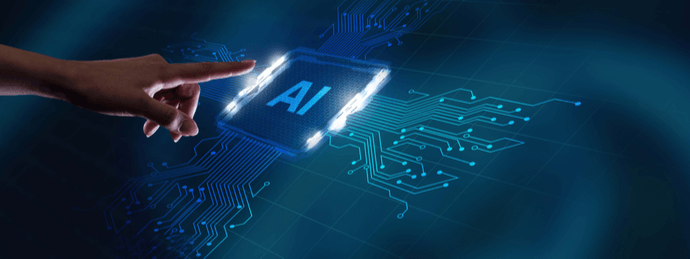Artificial intelligence uses computers and software to replicate human ways of problem-solving and decision-making. Anyone with only a basic understanding of AI technology would immediately associate it with robots.
But if you ask an AI researcher how artificial intelligence works, they will tell you that it is a series of algorithms that can generate results without being explicitly instructed to do so. And they would be right.
To summarize, the most common definition of artificial intelligence is: Humans have created an intelligent entity that is capable of intelligently performing tasks without being directly taught and capable of rational and human thinking, action, and decision-making
How is Artificial Intelligence Applied?
Artificial intelligence is commonly used to provide users with personalized suggestions based on past searches, purchases, and other online activities. In commerce, AI plays a critical role in product optimization, inventory planning, and logistics, among many other things.
Artificial Intelligence in education provides a valuable service to the world. In Artificial Intelligence, the Expert System is widely used. Spell correctors and spell checkers are the most common.
They serve as proofreaders, check for spelling and grammar errors, and offer all possible feedback to produce the best article possible.
In the automation industry, expert systems are used in 80% of the manufacturing process. Since the robot does not need a lunch break or a break hour, it saves labor costs, reduces errors, and produces maximum production in the shortest amount of time.
The man takes hours to perform a long and tedious job that the robot performs in seconds.
Human resources consider robotics with applied AI to be the most appealing and beneficial. Robots are programmed to perform repetitive tasks, resulting in increased productivity and efficient use of resources. Robots can diffuse, explore space, and be programmed to complete any job too risky for humans to perform.
Collision sensors, cameras, and ultrasound sensors are used in advanced robotics research to enable robots to see, hear, and touch. The robots are used in space exploration and can adapt to various conditions and physical conditions.
Emotions interfere with human intellectual thinking, which is a problem for artificial thinkers. A robot is designed to think critically and make effective decisions in comparison to emotional handling.
Artificial intelligence has been implemented and rising successfully in areas such as communication, time management, education, cognition, health, safety measures, traffic control, purchasing, marketing, shopping, and planning in our daily lives.
The Following Are The Key Five Elements That Make Artificial Intelligence Successful:
-
Discover
An intelligent system’s ability to explore data from available resources without human intervention is essential. The ETL algorithm then analyzes the extensive database and automatically determines the relationship between the material and the required problem solution. This not only solves a complicated problem but also identifies emergency phenomena.
-
Predict
This method uses classification, ranking, and regression to identify future events. Random forest, linear learners, and gradient boosting are the algorithms used here. When there is bias, estimation always goes wrong in some numerical values.
-
Justify
Human intervention is required for the application to produce a more identifiable and believable result. As a result, it must first comprehend and explain what is wrong and right and then provide humans with an appropriate response to the situation. Similarly, in the automation industry, it is essential to have a thorough understanding of the system to understand why it is being repaired and what needs to be done next.
-
Act
To discover, predict, and justify, intelligent applications should be active and live in the company.
-
Learn
The intelligent machine has a habit of studying and upgrading itself regularly to keep up with the world’s demands.
Artificial Intelligence Encompasses A Wide Range of Subfields, Including The Following.
-
Machine Learning | Learning from experience
Machine learning helps to automate the creation of various analytical and statistical models. It finds hidden insights in data using neural networks, statistics, operations analysis, and physics without being specifically programmed where to look or what to infer.
-
Neural Network | Making associations
A neural network is a form of machine learning inspired by the human brain’s activities. Neural Network is an interconnected unit (like brain neurons) that process data by responding to external inputs and relaying data between them. The process to find connections and relevant meaning from undefined data requires multiple passes at the data.
-
Deep Learning | Self-educating machines
Deep learning uses massive neural networks with several layers of processing units to learn complex patterns in vast volumes of data, taking advantage of advancements in computing power and improved training techniques. Picture and speech recognition are two popular applications.
-
Computer Vision | Understanding images
To know what’s in a picture or video, computer vision uses pattern recognition and deep learning. When machines can process, evaluate, and comprehend images, they can capture and interpret images and videos in real-time.
-
Natural Language Processing (NLP) | Understanding the language
Computers’ ability to analyze, understand, and generate human language is known as natural language processing. Natural language interaction is the next level of NLP, allowing humans to communicate with computers using everyday language to perform tasks.
Cognitive Computing | Making inferences from context
Though machine learning is based on the premise that machines should be able to learn and adapt through experience, AI is a broader term that refers to devices that can perform work “smartly.”
Conclusion
Machine learning, deep learning, and other methods are used in artificial intelligence to solve complex problems. Artificial intelligence systems are becoming more capable as their scale and complexity increase.
AI researchers are constantly developing software systems for various applications, including automatic learning, knowledge, speech recognition, and speech recognition. We looked at six branches of the Artificial Intelligence field based on how AI systems function. In the industries and organizations, the six areas have become a buzzword. Several companies are promoting it as a way to use it to serve their customers better.

